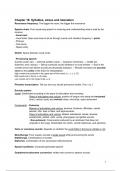Summary
Summary Linguistics (Ch 16, 18-20) - A. Baker and K. Hengeveld
- Course
- Institution
- Book
Summary of Linguistic book and lectures, written in English. It is about chapters 16 and 18 until 20. It contains notes taken during the (guest)lectures and summaries from the book Linguistics by A.E. Baker and K. Hengeveld.
[Show more]




